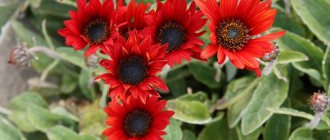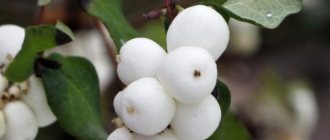Author: Elena N. https://floristics.info/ru/index.php?option=com_contact&view=contact&id=19 Category: Garden plants Published: January 20, 2019Last edits: January 13, 2021
- When to plant
- Rules of care
- Chinese wisteria (Wisteria chinensis)
flowers (Greek Glicinia - “sweet”) , or wisteria (Latin Wisteria) , belong to the genus of tree-like climbing plants of the Legume family, growing in subtropical regions and attracting attention with their fragrant, hanging purple inflorescences. The Latin name “wisteria” was given to the wisteria flower in honor of the professor of anatomy at the University of Pennsylvania Caspar Wistar. There are 9 known species of the wisteria genus, but only Chinese wisteria and Japanese wisteria, or abundantly flowering, are grown as garden crops.
Planting and caring for wisteria
- Planting: sowing seeds in the ground - in early spring, for seedlings - in December, planting seedlings in the ground - in May.
- Flowering: from late March to late summer.
- Lighting: bright sun in the first half of the day, then diffused light or partial shade.
- Soil: nutritious, well-drained, slightly alkaline.
- Watering: from spring to late summer - moderate: the soil in the tree trunk circle should be slightly moist all the time, and from mid-September watering is gradually reduced.
- Feeding: during the growing season, once a week alternately with mineral and organic solutions.
- Pruning: in summer, to maintain the shape of the bush.
- Reproduction: sometimes by seeds, but more often by layering.
- Pests: clover mites, aphids.
- Diseases: chlorosis.
Read more about growing wisteria below.
Pests
The most harmful enemies of wisteria are clover mites and aphids.
Aphid
If the leaves begin to dry, the branches become distorted, the flowers become smaller, and the plant withers, it means that the wisteria has been attacked by a colony of aphids.
You can get rid of these small parasites using one of the modern insecticides: Fitoverm, Karate, Intavir, Actellik.
Clover mite
A small parasite with an oval body of inconspicuous green or brown color. It is very difficult to notice - the body length barely reaches 0.4 mm. An attack can be detected by characteristic external signs.
The surface of the leaves becomes covered with small light streaks, then cracks. Affected leaves become twisted.
Acaricides work great against mites, completely ridding the plant of parasites. You can use Nissoran, Sunmite, Apollo, Fitoverm, Oberon, Omite.
Botanical description
The wisteria plant in nature is a woody deciduous vine with drooping branches, reaching 15-18 meters in height. Wisteria leaves are odd-pinnate, pubescent when young, up to 30 cm long, with the number of leaflets from 7 to 13. Fragrant purple, lilac or white flowers are collected in drooping racemes up to 30 cm long. Wisteria blooms in the spring, at the end of March and can bloom throughout the summer.
The wisteria tree is in great demand in landscape design; it is grown in various forms - both as a vine wrapping around the walls of a gazebo or fence frame, and as a standard tree. Wisteria is also grown at home in a container method in the form of a tree, but still, home wisteria is not as common as garden wisteria, so let’s talk about growing wisteria in the garden.
Peculiarities
Chinese wisteria, whose Latin name is Wisteria sinensis, is an ornamental vine belonging to the legume family. A representative of the genus Wisteria has a woody surface and reaches a height of 20 to 25 meters. The shoots naturally twist against their axis, and the young branches are also covered with snow-white fluff. The leaf blades can reach a length of almost 30 centimeters, consisting of 8-12 small leaves. Racemose inflorescences also grow to almost 30 or even 40 centimeters. The diameter of each flower ranges from 2 to 2.5 centimeters.
The corolla is painted in various shades of purple or white. The bell-shaped calyx is covered with fluff. The fruits of Chinese wisteria are pubescent beans, each of which contains from one to three brown seeds up to 1.5 centimeters long. The crop blooms from May to June, and fruits can appear from late spring to late summer. In good weather, secondary flowering occurs in September.
Growing wisteria from seeds
Growing conditions
Wisteria seeds are planted in late November or early December. Wisteria seeds are sown on the surface of a soil mixture consisting of leaf soil (four parts), turf soil and sand (one part each), sprinkled with a thin layer of sand on top, sprayed with water from a spray bottle and, covering the container with glass to create a greenhouse effect, placed in a dark, warm place. (22-25 ºС) place, keeping the soil slightly moist all the time. Wisteria sprouts from seeds in 3-4 weeks, and after another week and a half it will be possible to move the seedlings to the light, providing them with protection from direct sunlight.
- 2 proven methods for sowing eustoma seedlings - how to get friendly shoots?
When the seedlings have formed two leaves, they are planted in separate containers along with a lump of earth on the roots and watered with a weak solution of potassium permanganate.
Seedling care
Seedlings dropped into individual containers must be accustomed to the environment in which they will live. To do this, they need to be taken out to an unheated part of the house for a couple of hours a day or kept under a slightly open window, provided that there is no draft in the room.
You can sow wisteria seeds directly into open ground in early spring, then the seedlings grow adapted to their environment and subsequently delight with their hardiness.
What should I do to ensure that the vine takes root?
The development of wisteria from cuttings depends on many factors. What to do if you can’t root a vine? To ensure that the plant takes root, gardeners recommend taking into account several nuances:
- During autumn pruning, it is necessary to select planting material correctly.
- Only those cuttings that have adequately overwintered will germinate successfully.
- Pre-soaking the plant in synthetic auxins should not be ignored.
- After planting, the plant needs to be provided with diffused light, high humidity and sufficient moisture.
- If there are doubts about the sufficiency or excess of light, then to save the situation it is enough to move the box to another place.
- If the room has low humidity, it is recommended to place the box in a tray with pebbles filled with water.
Wisteria is an unpretentious plant. If you create suitable conditions for it and take care of the nutritional content of the soil, then the vine will not cause any trouble to its owners. Now you know how to grow wisteria from cuttings.
Planting wisteria
When to plant
Wisteria is planted in the spring, after the last frost has passed. All types of garden wisteria are cold-resistant, but it is better not to expose young plants to the risk of frostbite. Before planting wisteria, you need to determine in which area it will grow best - wisteria is not an annual, and if you are interested in the quality of flowering, then keep in mind that it should be in the sun for half a day, so choose the sunniest and most sunny place for planting. protected from gusts of wind, the soil is nutritious, well-drained and slightly alkaline.
How to plant
Wisteria seedlings are transplanted into holes measuring 60x60x50 cm, having previously added mineral fertilizers to the soil in the digging area at the rate of 25-30 g per square meter of planting area. Be prepared for the fact that wisteria will not show signs of life for some time - it grows for a long time, and in the first years it forms only long thin shoots. In general, you will be able to see beautiful flowers of wisteria grown from seeds only after 4-5, or even 10 years.
Trimming
Without pruning you will not be able to get a healthy flowering tree. This ritual is mandatory. And it is held twice a year. This allows you to form a beautiful crown and keep the shoots in good condition.
But, no matter what age, type and condition the vine is, there are several mandatory rules for pruning. Firstly, this is an annual procedure, so you shouldn’t skip it. It should be carried out only when it is sunny outside and there is no rain.
If you used chemical processing - no trimming, you'll have to wait. All tools for work must be treated with a sterilization composition. The resulting “wounds” need to be treated; ordinary garden varnish will do for these purposes. There are several types of pruning. It can be formative, sanitary and supportive.
Remember that you will definitely not be able to form a tree earlier than in three years. Begin work in the first year of planting. To do this, first select the main shoot. Next you will need to cut it by a third. You will have to get rid of the lateral shoots by plucking.
Next, the future trunk needs to be attached to the base, which is in a vertical position. In the next two years, do not forget to continue fixing the main shoot. You will also choose two new ones that, in your opinion, are quite strong and viable. Tie them at an angle of 45 degrees. And cut the side branches again by a third. In subsequent years, in the fall, new shoots are shortened by two-thirds, and last year's shoots are cut in half.
Next you need to monitor the appearance of new shoots; if they are located lower than thirty centimeters from the ground, you will have to remove them. And you cannot do without sanitary treatment: all dried or damaged areas must be removed.
Caring for wisteria in the garden
Rules of care
From spring to late summer, wisteria requires moderate watering so that the soil underneath is always slightly moist, but never wet. If there is no rain in spring, then you will have to water more diligently, because the buds may fall off and you will not see the flowers for which the plant was planted. From mid-September, watering is gradually reduced.
- Save on peat pots - tea bags
In order for wisteria to bloom on time and abundantly, it is fed once a week during the active growing season, alternating liquid mineral fertilizers (Kemira-lux, for example) with organic ones (mullein infusion in a ratio of 1:20). It is useful to water the wisteria with chalk water once a season (100 g of chalk per bucket of water). When the flowers begin to fade, remove the faded inflorescences. In addition, you will have to trim dry branches, tie them up and guide the shoots so that they do not fall and grow in the desired direction.
Before the onset of winter, you need to hill up the rosette high, remove the vine from the supports and lay it on the tree trunk, as is done with climbing roses, preparing them for wintering, and then sprinkle with dry leaves and cover with spunbond or lutrasil. You don’t have to do all this, but if there is no snow in winter, the wisteria may freeze.
Bloom
When does wisteria bloom? Chinese wisteria blooms at the age of three, Japanese - at the age of ten, so wisteria is a plant for those who can wait. Wisteria of Chinese varieties blooms from April, and all the buds open at the same time. Wisteria profusely blooms from May to June. Make sure that there is no excess nitrogen in the soil, otherwise the wisteria will grow greenery, but will not bloom.
Trimming
Wisteria is pruned to stimulate flowering and for plant formation. To form a standard tree, one strong shoot is selected and the rest are removed. If you grow wisteria as a climbing plant, then it is advisable to remove the abundantly growing side shoots so that the wisteria does not waste energy on overly growing greenery, but directs it to the formation of buds.
Pruning wisteria in the spring involves removing young shoots that stick out so that their foliage does not hide the flower clusters from view during flowering. In addition, a young lateral annual branch of wisteria can produce an inflorescence this year only if you shorten it to 30 cm.
Formative pruning of the plant is carried out in the summer: the side shoots are cut by 20-40 cm, and at the very end of summer by another 10-20 cm. However, try not to get carried away with the process, otherwise you may deprive yourself of the pleasure of seeing the lush bloom of wisteria.
Wisteria propagation
We have already described in this article the propagation of wisteria by seed. It is worth adding that many of the sprouted and even grown seedlings may never produce flowers - no one knows why this happens. But we have repeatedly told our readers that propagation by seeds is unreliable and it is much better to use vegetative methods of propagation.
- Two ways to sow balsam seedlings
Wisteria is most easily propagated by layering. To do this, in the spring, select a one-year-old shoot, make an oblique cut in the middle of its length, bend the shoot and place it with the cut on a pot with a clay-turf substrate, secure the branch in this position and dig in, leaving the top of the shoot free. It will be possible to separate the rooted cuttings from the mother plant only next spring.
Various publications write that it is possible to propagate wisteria by cuttings or grafting on roots, but I don’t know anyone who has actually succeeded in doing this, but my layerings have taken root.
Pests and diseases
Sometimes wisteria is invaded by aphids or clover mites. Aphids are destroyed with an insecticide, and mites - with an acaricidal drug. If wisteria grows in alkaline soil, it can be affected by chlorosis, which causes its leaves to turn yellow. To combat the disease, root fertilizing of wisteria with iron salts is used.
Bloom
The flowering of a wisteria tree looks like this - a large number of multi-colored brushes that fall down. Wisteria grown by seed begins to bloom after 10-15 years. Trees propagated by cuttings or rooting bloom after 5-7 years. Such planting methods provide more abundant and vibrant flowering.
A peculiarity of tree-like wisteria is the fact that the buds bloom first, and only then the leaf plates bloom from the buds.
If there is no flowering, this indicates the following errors in care:
- lack of light;
- infrequent watering or, conversely, stagnation of moisture in the soil;
- improper pruning.
In very dry regions, the tree does not always wake up after winter. The roots will recede over time, but the next flowering will occur in 2-3 years.
You cannot cover wisteria with wet material - such manipulation has a detrimental effect on budding.
Types and varieties
Chinese wisteria (Wisteria chinensis)
Densely leafy vine up to 15-20 m in height. The leaves are odd-pinnate, large, initially pubescent, but become smooth over time. The flowers are in loose racemes up to 30 cm long and light lilac in color. The fruit is a bean up to 15 cm long. This species has a garden form with white flowers (f. alba) and a form with double flowers (f. plena).
Wisteria floribunda
It is also colloquially “Japanese”, since it comes from the Japanese islands - it differs from the Chinese one in its smaller size (only 8-10 m in length), larger leaves up to 40 cm in length and the number of leaves up to 19, a large number of inflorescences on the plant, and also their larger sizes - up to 50 cm in length. The flowers themselves are smaller than those of Chinese wisteria, violet-blue in color, and bloom gradually, starting from the base of the cluster. This species is more cold-hardy than Chinese wisteria. There are garden forms with white, pink, purple double flowers and a variegated form with variegated leaves.
In addition to these two most popular species, beautiful wisteria (Wisteria venusta), bush wisteria (Wisteria frutescens) and large-tasted wisteria (Wisteria macrostachys) are also known in cultivation, on the basis of which American gardeners from Minnesota developed Blue Moon wisteria, which can winter in the garden even without shelters.
Content
- Chinese wisteria Description
- Bloom
- Varieties and forms
- Description
- Description
Takashi Hososhima / Personal archive
If among trees the queen of flowering is considered to be magnolia, then among lianas it is wisteria . A unique group of brightly flowering of alien beauty , with extremely rapid growth and regeneration. Wisterias (aka Wisteria) have only one drawback - insufficient frost resistance for abundant flowering in the Middle Zone, but gardeners have also achieved a breakthrough .
The topic will be important to everyone who loves royally lush flowering in gardens and is ready for a unique feat for this. Of the 9-10 types of wisteria, the most winter-hardy are considered to be large-clustered, Chinese, Japanese (abundantly flowering), beautiful and shrubby.











